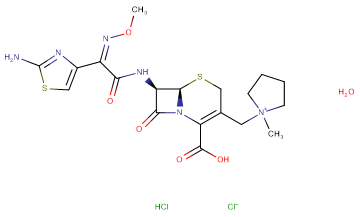
Cefepime Dihydrochloride Monohydrate
CAS No. 123171-59-5
Cefepime Dihydrochloride Monohydrate( Cefepime Hydrochloride | Cefepime HCl | Cefepime hydrochloride monohydrate )
Catalog No. M10913 CAS No. 123171-59-5
Cefepime Dihydrochloride Monohydrate is a broad-spectrum cephalosporin with enhanced coverage against Gram-positive and Gram-negative bacteria.
Purity : >98% (HPLC)
 COA
COA
 Datasheet
Datasheet
 HNMR
HNMR
 HPLC
HPLC
 MSDS
MSDS
 Handing Instructions
Handing Instructions
| Size | Price / USD | Stock | Quantity |
| 500MG | 35 | In Stock |


|
| 1G | Get Quote | In Stock |


|
Biological Information
-
Product NameCefepime Dihydrochloride Monohydrate
-
NoteResearch use only, not for human use.
-
Brief DescriptionCefepime Dihydrochloride Monohydrate is a broad-spectrum cephalosporin with enhanced coverage against Gram-positive and Gram-negative bacteria.
-
DescriptionCefepime Dihydrochloride Monohydrate is a broad-spectrum cephalosporin with enhanced coverage against Gram-positive and Gram-negative bacteria. (In Vitro):Cefepime is an extended-spectrum parenteral cephalosporin antibiotic active in vitro against a broad spectrum of gram-positive and gram-negative aerobic bacteria. Cefepime has a decreased propensity to induce beta-lactamases compared with other beta-lactam antibiotics.(In Vivo):Cefepime has a pharmacokinetic disposition similar to that of other renally eliminated cephalosporins, with a half-life of approximately 2 hours. Cefepime has demonstrated clinical efficacy against a variety of infections, including urinary tract infections, pneumonia, and skin and skin structure infections. Cefepime is generally well tolerated.
-
In VitroCefepime is an extended-spectrum parenteral cephalosporin antibiotic active in vitro against a broad spectrum of gram-positive and gram-negative aerobic bacteria. Cefepime has a decreased propensity to induce beta-lactamases compared with other beta-lactam antibiotics.
-
In VivoCefepime has a pharmacokinetic disposition similar to that of other renally eliminated cephalosporins, with a half-life of approximately 2 hours. Cefepime has demonstrated clinical efficacy against a variety of infections, including urinary tract infections, pneumonia, and skin and skin structure infections. Cefepime is generally well tolerated.
-
SynonymsCefepime Hydrochloride | Cefepime HCl | Cefepime hydrochloride monohydrate
-
PathwayGPCR/G Protein
-
TargetAntibacterial
-
RecptorPBPs| Fts1
-
Research AreaInfection
-
Indication——
Chemical Information
-
CAS Number123171-59-5
-
Formula Weight571.5
-
Molecular FormulaC19H24N6O5S2·2HCl·H2O
-
Purity>98% (HPLC)
-
SolubilitySoluble in DMSO
-
SMILESC[N+]1(CCCC1)CC2=C(N3[C@@H]([C@@H](C3=O)NC(=O)/C(=N\OC)/C4=CSC(=N4)N)SC2)C(=O)O.O.Cl.[Cl-]
-
Chemical Name(6R,7R)-7-[[(2Z)-2-(2-amino-1,3-thiazol-4-yl)-2-methoxyiminoacetyl]amino]-3-[(1-methylpyrrolidin-1-ium-1-yl)methyl]-8-oxo-5-thia-1-azabicyclo[4.2.0]oct-2-ene-2-carboxylic acid;chloride;hydrate;hydrochloride
Shipping & Storage Information
-
Storage(-20℃)
-
ShippingWith Ice Pack
-
Stability≥ 2 years
Reference
1.Grassi GG, Grassi C. J Antimicrob ChemOthers. 1993 Nov;32 Suppl B:87-94.
molnova catalog



related products
-
TH1020
TH1020 is a novel Inhibitor of Toll-Like Receptor 5 (TLR5)/Flagellin Complex with promising activity (IC50 =0.85±0.12?μm) and specificity.
-
Phenazine methosulfa...
Phenazine methosulfate is anti-bacterial agents.
-
Isoprothiolane
Isoprothiolane is a foliar spray fungicide with eradicant and protectant activities against fungal diseases of rice plant caused by Pyvioutavia oryzae Cav.



 Cart
Cart
 sales@molnova.com
sales@molnova.com


